AMAZON multi-meters discounts AMAZON oscilloscope discounts
[Note: various equations, denoted by "e." are not yet avail., but coming soon.]
[cont. from part 1]
4. Remediation of Arc Flash Hazards
4.1 Example: Correcting an Arc Flash Problem When a Coordination Problem Requires Replacing Trip Units
In this older substation (FIG. 1), the low-voltage circuit breakers use electromechanical dashpot-type trip (FIG. 2) units with wide characteristics (FIG. 3). The main breaker has an instantaneous only characteristic (vertical bar on the time-current curve). The transformer protection is from an older inverse-time overcurrent relay, with nearly definite time characteristics. The relay and low-voltage circuit breakers do not coordinate in this situation, such that the only practical solution is an upgrade to modern electronic equipment.
The 600 V transformer secondary and bus, both have high levels of incident energy, exceeding , as shown in Figure 4. Arc flash hazard risks can be reduced to less than on the transformer secondary and 600 V bus by reducing the time dial of the relay from 1.5 to 0.5, as shown in Figures 5, 6, and Table 1. This does not significantly change the coordination, or lack thereof, because the actual tie breaker characteristics, defined by a dashpot-type trip unit, are probably not very close to the published curve. Dashpots of these old-type circuit breakers tend to suffer from drying out of oil and lack of the correct dashpot oil for maintenance.

FIG. 1 Single line diagram of older substation whose low-voltage circuit
breakers use electromechanical dashpot-type trip units.
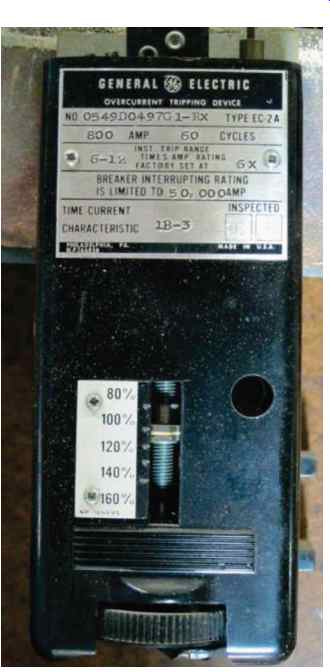
FIG. 2 Typical electromechanical trip unit for low-voltage circuit breaker.

FIG. 3 Coordination curves for substation of FIG. 1, as found.).
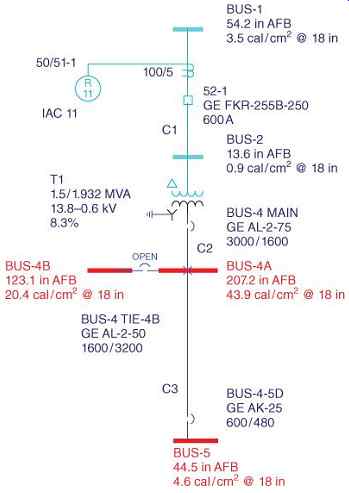
FIG. 4 Arc flash results for substation of FIG. 1, as found.).

FIG. 5 Coordination curves for substation of FIG. 1, showing recommended
changes © IEEE (2009a).
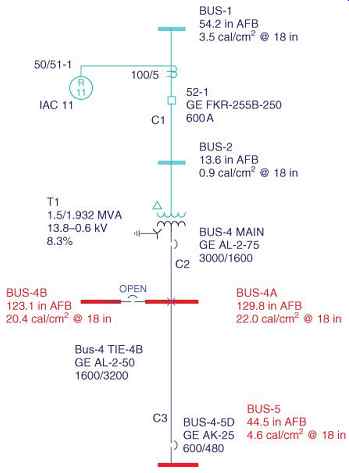
FIG. 6 Arc flash results for substation of FIG. 1, showing recommended changes.
=========
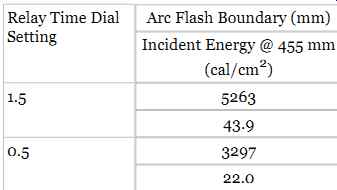
Table 1 Arc Flash Results at BUS-4 Versus Time Dial Setting for Relay 50/51-1
for FIG. 1
========
The instantaneous unit on the main breaker is set high, at the same value as the instantaneous unit of the tie breaker. However, the main breaker has no short-time or long-time delay units. Therefore, no changes of primary relay setting or relay curve shape will alleviate the coordination problem.
The only practical solution is to update the low voltage circuit breakers with solid-state trip units. However, the arc flash problem needs to be corrected now, while the circuit breakers might not be updated or replaced for some time. The arc flash hazard can be reduced, while the coordination problem should be addressed separately. When this occurs, the fact that the relay setting has been lowered to reduce arc flash hazard should not be forgotten.
4.2 Example: Correcting a Coordination Problem Without Introducing an Arc Flash Problem
In the existing configuration of this feeder, FIG. 7, there is initially a severe arc flash problem, as shown in line 1 of Table 2, as well as a coordination problem, FIG.
This relay does not protect the 500 kVA transformer because the pickup is too high. It also does not coordinate with the main breakers on the 1500 kVA substation.

FIG. 7 Original configuration of 600 V substations on a 13.8 kV feeder with
normal inverse relays.
Table 2 Arc Flash Results at BUS-16 Versus Time Dial Setting for Relay R1
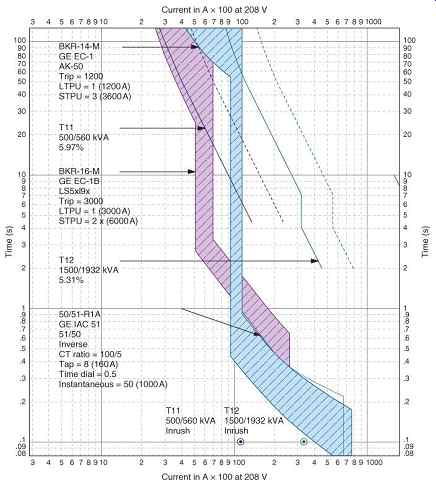
FIG. 8 Original coordination of 600 V substations on a 13.8 kV feeder.
It was decided to upgrade the feeder with a relay having a very inverse time current curve for better coordination characteristics ( FIG. 9). If the relay is set to protect the 500 kVA transformer ( FIG. 10 and line 2 of Table 2), there is a coordination problem, in that the relay set to does not coordinate with the protection for the 1500 kVA transformer ( FIG. 11).

FIG. 9 Two 600 V substations on a 13.8 kV feeder with very inverse relays;
protection of 500 kVA transformer.
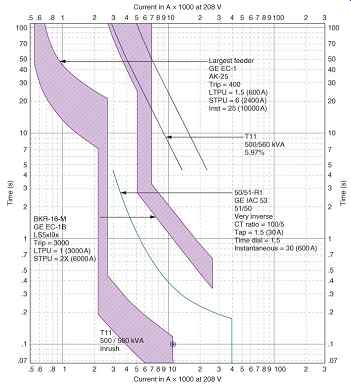
FIG. 10 Protection of 500 kVA transformer.

FIG. 11 Protection of 1500 kVA transformer with 500 kVA settings.
The other alternative of setting the relay for the 1500 kVA (Figures 12, 13, and line 3 of Table 2) transformer leaves the 500 kVA unit unprotected ( FIG. 14) and raises the incident energy to unacceptable levels.

FIG. 12 Two 600 V substations on a 13.8 kV feeder with very inverse relays;
protection of 1500 kVA transformer.

FIG. 13 Protection of 1500 kVA transformer with settings for arc flash reduction.

FIG. 14 Protection of 500 kVA transformer with 1500 kVA settings.
One solution to this dilemma is the use of a transformer primary fuse on the 500 kVA transformer, such that the incident energy is within acceptable limits on the 600 V bus. This will allow the primary relay R1 to be set to protect the 1500 kVA transformer.
It is important to select the proper fuse when remediating arc flash hazards. Two different fuses of the same rating and manufacturer, even if both are current-limiting fuses, may have completely different arc flash limitation characteristics. This is shown in FIG. 15 and Table 3, where, for this situation the fuse in line 1 has an incident energy of…, while that in FIG. 16 and in Table 3, line 2 has , which is in the extreme danger category.
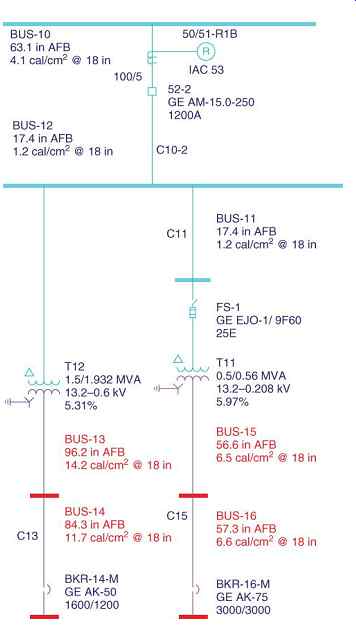
FIG. 15 Two 600 V substations on a 13.8 kV feeder, with fast fuses on the
smaller substation.
Table 3 Arc Flash Results at BUS-16 Versus Fuse Type (R1 at 6.0AT, 0.5TD)

FIG. 16 Two 600 V substations on a 13.8 kV feeder, with slow fuses on the
smaller substation.
Looking at the time-current curves ( FIG. 17), the Fuse 1 curve sweeps down and to the left, providing short clearing times across the range of high available fault currents. However, the Fuse 2 curve is steep, providing long clearing times at all but the highest fault currents. An example of changing a slow fuse for a fast fuse can also be found in (Doan and Sweigart, 2003).

FIG. 17 Comparison of fuse-time-current curves.
5. Coordination of Low-Voltage Breaker Instantaneous Trips for Arc Flash Hazard Reduction
The practice of performing coordination studies for industrial, commercial, and institutional power systems has been regulated in many ways by the National Electrical Code (NEC) (NFPA, 2014) and NFPA 70E, Standard for Electrical Safety in the Workplace (NFPA 70E) (NFPA, 2012). In recent years, an apparent difficulty has arisen owing to requirements in the NEC for coordination of protective devices which are difficult to implement without increasing the incident energy. An emergency system (ES) is defined as a system which is legally required, and which automatically supplies power and light to designated areas, or to areas where power and light are essential for human health and safety. Clause 700.28 of the NEC, added in 2005, requires the protective devices of an ES to be selectively coordinated with all upstream devices (Valdes et al., 2009; Valdes, Hansen, and Sutherland, 2012).
Clause 701.27 adds the same requirement for "legally required standby systems" (LRSS). An LRSS is defined as a standby system which is legally required, and which automatically supplies power to selected loads, which are not classified as ESs. Both types of systems are normally seen in hospitals, nursing homes, and other health-care facilities.
Another type of system where coordination is required is the "critical operations power system" (COPS). This is for facilities such as "public safety, emergency management, national security, or business continuity." Clause 708.54 provides similar requirements for coordination as the ones mentioned previously.
When the load consists of hoists or people movers, in particular, "elevators, dumbwaiters, escalators, moving walks, platform, and stairway chairlifts," NEC Clause 620.62 requires coordination when more than one machine is supplied by a single feeder. The purpose of this is to prevent the failure of one elevator (for example) to result in the shutdown of other elevators.
When an arc flash hazard analysis is performed for a hospital, it is often found that in order to lower incident energy levels, instantaneous trip devices must be used and set lower than is normal in a protective device coordination study alone (Hodder et al., 2006; Brown and Shapiro, 2009). Recently, the "energy boundary curve" (EBC) method has been developed to aid in this analysis (Parsons et al., 2008; Valdes, Crabtree, and Papallo, 2010b). In the following examples, the EBC technique will be applied to practical solutions to mitigate coordination in ES and LMSS.
5.1 Hospital #1-Time-Current Curve Examples
This example concerns the emergency switchgear, designated "EMSW," in a typical hospital. The one-line diagram is shown in FIG. 18, and the TCC in FIG. 19. This diagram depicts the coordination between the main circuit breaker of the bus EMSW, the largest feeder breaker of the switchgear, and the largest downstream breaker on the bus ES.
With the settings as shown in the TCC, both busses EMSW and ES have incident energy at the working distance of greater than .
This level of incident energy is greater than the recommended limit for arc flash PPE. The incident energy levels on both busses can be reduced to less than by adjusting breaker settings as shown in FIG. 20.
Because the incident energy is less than , this places the working distance outside the arc flash boundary. By Clause 130.5 (B)(1) of NFPA 70E-2012 (NFPA, 2012), the worker is not required to wear arc-rated clothing or other PPE. However, the worker should still wear appropriate protective clothing, such as specified for Hazard Risk Category 0 in NFPA 70E Table 130.7(C)(16).

FIG. 18 One-line diagram EMSW, Hospital #1.

FIG. 19 Time-current curves EMSW, Hospital#1, >40 cal/cm2.

FIG. 20 Time-current curves EMSW, Hospital#1, <1.2 cal/cm2.
The circuit breaker DP-CB-ES is a molded-case circuit breaker with a thermal magnetic trip unit. The frame size is 600 A and the trip unit pickup is set at 500 A. The instantaneous trip setting is reduced from 3250 to 3020 A.
The circuit breaker "ES" is a molded-case circuit breaker with an electronic trip unit. The frame size is 1200 A and the sensor rating 1200 A, with a trip unit having a 1000 A rating plug.
The instantaneous trip setting is reduced from 7880 to 3020 A.
The 1600-A generator circuit breaker "GEN" is a power circuit breaker with an electronic trip unit. The frame size is 1600 A, and the tapped 1600 A current sensor is set at 1600 A. The instantaneous trip setting is reduced from 12,800 to 3200 A.
However, when this is done, there is no coordination at the instantaneous level. We can determine which devices can be selective from the manufacturer's selectivity tables (General Electric Company, 2008a, b) (Mitolo, Cline, Hansen, Papallo, 2010). This selectivity will only apply if there are current-limiting circuit breakers or fuses in the circuit.
The arc flash hazard levels must also be checked with the ATS in the normal position. In this case, the results are similar, because the fault current is limited by the 300 kVA, 208 V transformer.
In this example, the generator breaker is not current limiting. The next combination circuit breaker "ES" with an electronic trip unit is, followed by the thermal magnetic MCCB "DP-CB-ES." This particular combination can only be coordinated by the TCC and not by instantaneous let-through current (General Electric Company, 2008b, p. 27). The next pair is the 600 A breaker "DP-CB-ES" and the 208 V, 1200 A circuit breaker, "DP-CB." Both are thermal magnetic MCCBs. This pair cannot be coordinated instantaneously and do not appear in the manufacturers tables. The TCC for this pair shows only normal coordination of curves and no special instantaneous trip modifications.
When the feeder is supplied by normal power (Figures 10.21 and 10.22), the available fault current increases from 11 to 16 kA on the 208 V bus. The coordination is now with a stored-energy circuit breaker, which does not have an instantaneous trip. In order to keep arc flash energies at the switchgear bus low, the coordination with the downstream 208 V breaker has been omitted.
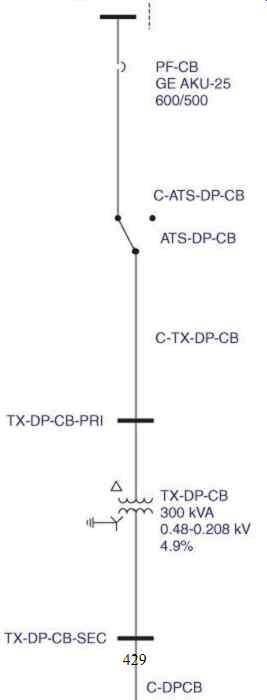
FIG. 21 One-line diagram normal feed, Hospital #1.

FIG. 22 Time-current curves for Hospital#1, normal.
5.2 Hospital #2-Time-Current Curve Examples
This example concerns the coordination between the main and largest feeder breaker of the emergency bus in another typical hospital, down to the uninterruptible power supply (UPS) in the ES. The one-line diagram is shown in Figure. The time-current curve in FIG. 24 depicts coordination between main and largest feeder breaker of bus BEDP1, the largest feeder breaker of bus B1-EMRG, and the main breaker of bus BG IT UPS-MAIN.

FIG. 23 One-line diagram emergency feed, Hospital #2.

FIG. 24 Time-current curves emergency feed, Hospital #2.
The 800 A main circuit breaker MCB #B-68 of the emergency bus BEDP1 and the 600-A feeder breaker ATS-B1/B2 B70 are current limiting MCCBs with electronic trip units, which are "not instantaneously selective" (General Electric Company, 2008b, p. 37). The reason for this is that the ratio of rating plug sizes is too small. If the upstream breaker were 1000 A, or the downstream 500 A, they would be selective to a certain current level.
The fault current level is 8.1 kA, which is below the defined current-limiting region of the circuit breakers ( FIG. 25). The available fault current is below where the 240 V the current-limiting curve leaves the square-root-of-two line (Valdes, Crabtree, and Papallo, 2010). The start of current limiting for the thermal magnetic circuit breaker BG-IT-UPS B61 can be seen clearly in the let-through energy curves ( FIG. 26). This is typical of systems with generators and low available fault current.

FIG. 25 Let-through current curve for 600 A breaker in Hospital #2. Available
fault current is 8096 A. The diagonal line is square root of two line.
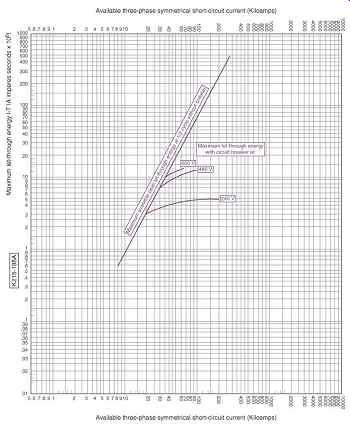
FIG. 26 Let-through energy curves for 400 A thermal magnetic circuit breaker
in Hospital #2.
The second pair of circuit breakers to be evaluated is the 300 A thermal magnetic circuit breaker BG-IT-UPS B61 and the 125 A thermal magnetic circuit breaker BG-IT-UPS.. This pair cannot be coordinated instantaneously, and do not appear in the manufacturers tables. The resulting TCC ( FIG. 24) shows only normal coordination of curves, and no special instantaneous trip modifications. With these settings, the following arc flash incident energy levels have been calculated:
Bus BEDP1:
Bus B1-EMRG:
Bus BG IT UPS:
The arc flash hazard levels must also be checked with the ATS in the normal position.
When the feeder is supplied by normal power, as shown in the one-line diagram of FIG. 27 and the time-current curve in FIG. 28, the available fault current increases from 3.7 to 8.3 kA on the 208 V bus. The coordination is now between the thermal magnetic circuit breaker B1-EMG-SWL B9, which does not have instantaneous coordination, and the 300 A thermal magnetic circuit breaker BG-IT-UPS B61. In order to keep arc flash energies at the switchgear bus low, the coordination with the downstream 208 V breaker has been omitted. In this case, the results are better, with the bus B1-EMRG below because of the lower setting on the upstream breaker. The lower-current emergency case becomes the higher arc flash hazard situation.
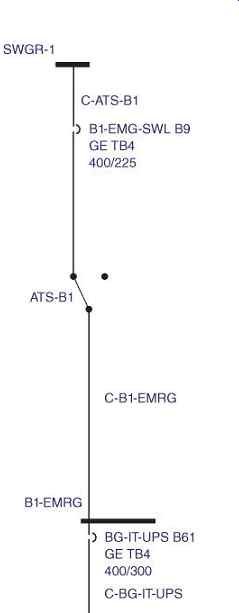
FIG. 27 One-line diagram normal feed, Hospital #2.

FIG. 28 Time-current curves normal feed, Hospital #2.
5.3 Hospital #3-Time-Current Curve Examples
The one-line diagram of FIG. 29 shows an 800 kVA emergency generator which can feed the emergency load via the main breaker GEN MAIN on the bus GENERATOR GEAR then through feeder breakers FDR G3 and FDR G4.
FIG. 30 depicts coordination between the main breaker and the two largest feeder breakers of the bus GENERATOR GEAR.
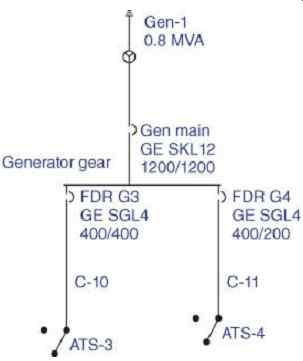
FIG. 29 Hospital #3, emergency generator system one-line diagram.
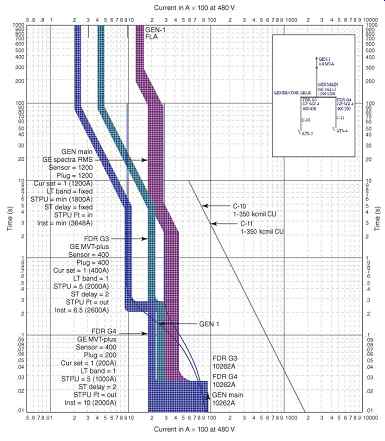
FIG. 30 Hospital #3, emergency generator system time-current curves.
The first two breakers to be coordinated are electronic trip current-limiting MCCBs, which are the 1200-A main breaker followed by the largest feeder, which is rated at 400 A. This pair is selective up to an available fault current of 10.8 kA (General Electric Company, 2008b, p.
Because the available fault current is calculated to be 10.3 kA, the two breakers are selective.
When the coordination is examined using let-through current tables, it is found that the fault current level of 10.3 kA is below the defined current-limiting region of the circuit breakers GEN MAIN and FDR G3 ( FIG. 31). The available fault current is below where the 480 V current-limiting curve leaves the square-root-of-two line (Valdes, Crabtree, and Papallo, 2010). The start of current limiting can also be seen clearly in the let-through energy curves. This is typical of systems with generators and low available fault current.

FIG. 31 Let-through current curve for 400 A circuit breaker in Hospital #3
emergency system.
The second pair of circuit breakers to be examined are the 1200 A main breaker GEN MAIN followed by the 200 A feeder FDR G4.
This pair is also selective up to an available fault current of 10.8 kA (General Electric Company, 2008b, p. 21). Because the available fault current is calculated to be 10.3 kA, the two breakers are selective.
With these settings, the following arc flash incident energy levels have been calculated:
Bus GENERATOR GEAR:
Feeder G3:
Feeder G4:
Thus, by using selectivity tables, breaker coordination and arc flash reduction can be achieved.
The arc flash hazard levels must also be checked with the ATS in the normal position. In this case, the results are similar, with the buses ATS3 and ATS4 at very low levels of incident energy.
The one-line diagram of FIG. 32 shows a utility service which can feed the emergency load via the 3000 A insulated case circuit breaker (ICCB) and main breaker SERVICE MCB on the bus HV-MDB then through current-limiting MCCB feeder breakers HV-MDB-3 (200 A) and HV-MDB-5 (400 A).

FIG. 33 depicts coordination between the main and the two largest feeder
breakers of the bus HV-MDB.

FIG. 32 Hospital #3, normal feed one-line diagram.

FIG. 33 Hospital #3, normal system time-current curves.
According to the selectivity tables, instantaneous coordination occurs up to 46 kA (General Electric Company, 2008b, p. 14). The rms let-through current of the MCCBs by the up-over-down method for 76 kA ( FIG. 34) is 38 kA. Because the 6000 A instantaneous pickup setting of the ICCB is below the let-through current, instantaneous coordination exists.

FIG. 34 Let-through current curve for 400 A breaker in Hospital #3 normal
system.
The available fault current is 76 kA.
6. Low-Voltage Transformer Secondary Arc Flash Protection using Fuses
The secondary of a low-voltage transformer, typically 480 V, is a particularly hazardous area in regards to arc flash ( FIG. 35). As discussed previously (e.g., FIG. 12), the primary protection is designed to protect the transformer from damage, and does not usually provide arc flash protection on the secondary side. The zone of arc flash hazard extends from the secondary terminals of the transformer, through the secondary transition compartment, to the line side terminals of the substation main breaker ( FIG. 36).
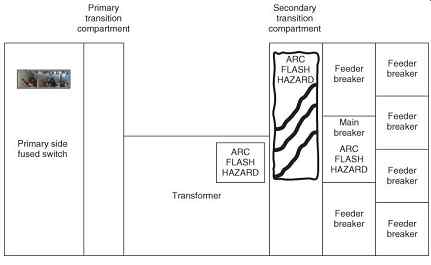
FIG. 35 Elevation view of low-voltage substation showing arc flash hazard
areas.
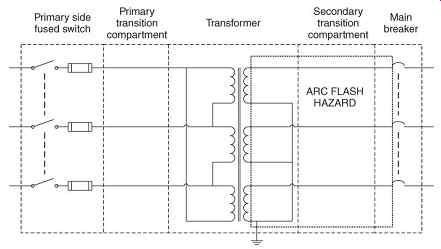
FIG. 36 Three-line diagram of low-voltage substation showing arc flash hazard
areas.
An arc flash hazard reduction system for use in a power substation can be designed using current-limiting protection devices such as current-limiting protection fuses (e.g., a high-speed and high-current fuse) which are placed between a transformer and switchgear having a main circuit breaker, such that the current-limiting protection devices are directly connected to the secondary windings of the transformer ( FIG. 37). Placing the current-limiting protection devices between the secondary windings of the transformer and the switchgear provides arc flash hazard reduction capability in a region of a power substation that is designated as an "extreme danger" area because it can have incident energy levels that are higher than about 40 cal/cm2. Benefits of this scheme include providing arc flash hazard reduction in regions of a power substation that can have incident energy levels that are greater than about 40 cal/cm2. This enables workers to perform maintenance on such areas without having to shut down and de-energize equipment. Performing maintenance on "extreme danger" regions without having to shut down and de-energize equipment results in increased productivity of the power substation.

FIG. 37 Three-line diagram of low-voltage substation showing arc flash reduction
using high-speed fuses (HSF).
The type of fuse which must be used for this application is not the typical current-limiting fuse used in electrical power distribution. It must rather be a high-speed device, such as is used for the protection of semiconductor devices, but yet has high enough ratings that it may be used in this application. In particular, it must have a continuous current rating higher than the maximum current output of the transformer, plus a safety margin, an interrupting rating higher than the maximum bolted fault current at the transformer secondary, again with a safety margin, and finally, a clearing time which is sufficient such that for an arcing fault with reduced current, the total incident energy is less than… .
Square body fuses having characteristics such as: 550 V, 2000 A, clearing, are one example of commercially available high-speed, high-current fuses that may be used. There are other high-speed, high-current fuses of comparable size, rating (e.g., 800, 1200, 1600, and 2400 A) and clearing time that may be used as a current-limiting protection device for limitation of arc flash hazards. The appearance ( FIG. 38), time-current curve ( FIG. 39), and peak let-through curve ( FIG. 40) of a typical fuse which could be used in this application are shown here. The dashed line area in the time-current curve should not be used, and this area should be coordinated with the primary protection. A full arc flash hazard analysis should be performed for every application.
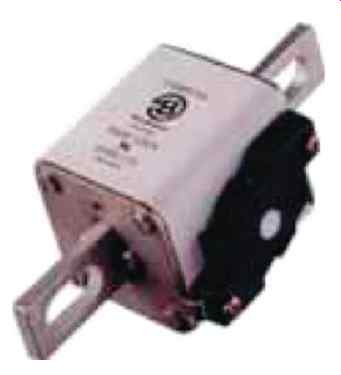
FIG. 38 Appearance of typical high-speed, high-current, low-voltage fuse
(Cooper Bussman).
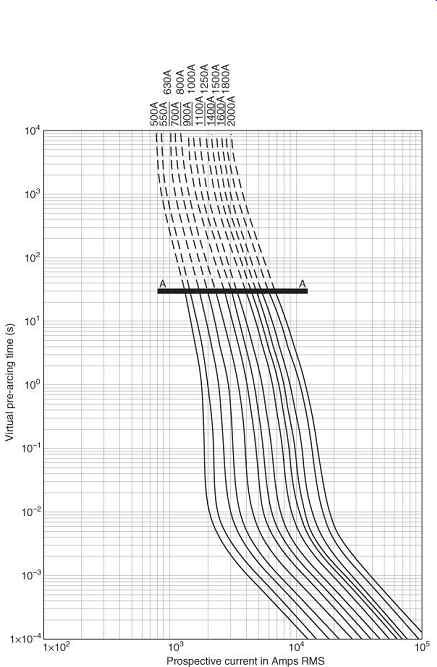
FIG. 39 Typical time-current curve for high-speed, high-current, low-voltage
fuse (Cooper Bussman).

FIG. 40 Typical peak let-through curve for high-speed, high-current, low-voltage
fuse (Cooper Bussman).
Other current-limiting protection devices may be suitable for use with this scheme. For example, current-limiting circuit breakers, "Is limiters" or "CLIP" devices may be used, as long as they can provide the necessary degree of current limitation.